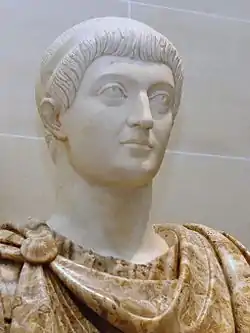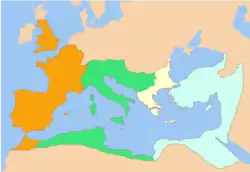Constans
Flavius Julius Constans (c. 320 – 350) was Roman emperor from 337 to 350. He held the imperial rank of caesar from 333, and was the youngest son of Constantine the Great.
| Constans | |||||||||
|---|---|---|---|---|---|---|---|---|---|
 Portrait head of Constans set in a modern bust (Louvre) | |||||||||
| Roman emperor | |||||||||
| Augustus | 9 September 337 – 18 January 350 | ||||||||
| Predecessor | Constantine I | ||||||||
| Successor | Magnentius and Vetranio | ||||||||
| Co-emperors | Constantine II (Gaul, Hispania and Britain, 337–340) Constantius II (East) | ||||||||
| Caesar | 25 December 333 – 9 September 337 | ||||||||
| Born | c. 320 | ||||||||
| Died | January 350 (aged 27 or 30)[1] Vicus Helena, southwestern Gaul | ||||||||
| |||||||||
| Dynasty | Constantinian | ||||||||
| Father | Constantine I | ||||||||
| Mother | Fausta | ||||||||
| Religion | Nicene Christianity | ||||||||
After his father's death, he was made augustus alongside his brothers in September 337. Constans was given the administration of the praetorian prefectures of Italy, Illyricum, and Africa.[3] He defeated the Sarmatians in a campaign shortly afterwards.[3] Quarrels over the sharing of power led to a civil war with his eldest brother and co-emperor Constantine II, who invaded Italy in 340 and was killed in battle with Constans's forces near Aquileia.[3] Constans gained from him the praetorian prefecture of Gaul.[3] Thereafter there were tensions with his remaining younger brother and co-augustus Constantius II (r. 337–361), including over the exiled bishop Athanasius of Alexandria.[3] In the following years he campaigned against the Franks and in 343 visited Roman Britain.[3]
In January 350, Magnentius (r. 350–353) the commander of the Jovians and Herculians, a corps in the Roman army, was acclaimed augustus at Augustodunum (Autun) with the support of Marcellinus, the comes rei privatae.[4] Magnentius overthrew and killed Constans.[3][4] Surviving sources, possibly influenced by the propaganda of Magnentius's faction, accuse Constans of misrule and of homosexuality.[3]
Early life
Constans was probably born in 320.[1] He was the third and youngest son of Constantine the Great and Fausta, his father's second wife.[5] He was the grandson of both the augusti Constantius I and Maximian.[1] When he was born his father Constantine was the empire's senior augustus, and at war with his colleague and brother-in-law Licinius I (r. 308–324). At the time of Constans's birth, his eldest brother Constantine II and his half-brother Crispus, Constantine's first-born son, were already reigning as caesar. Constans's half-aunt Flavia Julia Constantia was Licinius's wife and mother to another caesar, Licinius II.
After the defeat of Licinius by Crispus at the Battle of the Hellespont and at the Battle of Chrysopolis by Constantine, Licinius and his son resigned the purple and were spared at Constantine's half-sister's urging. Licinius was executed on a pretext shortly afterwards.
In 326, Constans's mother Fausta was put to death. She was killed on Constantine's orders, as were Constans's half-brother Crispus and Licinius II. This left Constans's branch of the Constantinian dynasty – descended from Constantius I's relationship with Helena – in control of the imperial college.
According to the works of both Ausonius and Libanius he was educated at Constantinople under the tutelage of the poet Aemilius Magnus Arborius, who instructed him in Latin.[1]
Reign
Caesar
On 25 December 333, his father Constantine I elevated Constans to the imperial rank of caesar at Constantinople.[1] He was nobilissimus caesar alongside his brothers Constantine II and Constantius II.[1] Constans became engaged to Olympias, the daughter of the praetorian prefect Ablabius, but the marriage never came to pass.[5] Official imagery was changed to accommodate an image of Constans as co-caesar beside his brothers and their father the augustus.[6]
It is possible that the occasion of Constans's elevation to the imperial college was timed to coincide with the celebration of the millennium of the city of Byzantium, whose re-foundation as Constantinople Constantine had begun the previous decade.[6] In 248, Rome had celebrated its own millennium, the Saecular Games (Latin: ludi saeculares), in the reign of Philip the Arab (r. 244–249).[6] Philip may also have raised his son to co-augustus at the start of the anniversary year.[6] Rome had been calculated by the 1st-century BC Latin author Marcus Terentius Varro to have been founded by Romulus in 753 BC.[6] Byzantium was thought to have been founded in 667 BC by Byzas, according to the reckoning derived from the History of the Peloponnesian War by Thucydides, the 5th-century BC Greek historian and used by Constantine's court historian Eusebius of Caesarea in his Chronicon.[6]
Augustus
.png.webp)
With Constantine's death in 337, Constans and his two brothers, Constantine II and Constantius II, divided the Roman world among themselves[7] and disposed of virtually all relatives who could possibly have a claim to the throne.[8] The army proclaimed them augusti on 9 September 337.[1] Almost immediately, Constans was required to deal with a Sarmatian invasion in late 337, in which he won a resounding victory.[5]

Constans was initially under the guardianship of Constantine II. The original settlement assigned Constans the praetorian prefecture of Italy, which included Northern Africa. Constans was unhappy with this division, so the brothers met at Viminacium in 338 to revise the boundaries. Constans managed to extract the prefecture of Illyricum and the diocese of Thrace, provinces that were originally to be ruled by his cousin Dalmatius, as per Constantine I's proposed division after his death.[8] Constantine II soon complained that he had not received the amount of territory that was his due as the eldest son.[9]

Annoyed that Constans had received Thrace and Macedonia after the death of Dalmatius, Constantine demanded that Constans hand over the African provinces, which he agreed to do in order to maintain a fragile peace.[9][10] Soon, however, they began quarreling over which parts of the African provinces belonged to Carthage and Constantine, and which parts belonged to Italy and Constans.[11] This led to growing tensions between the two brothers, which were only heightened by Constans finally coming of age and Constantine refusing to give up his guardianship. In 340 Constantine II invaded Italy.[10] Constans, at that time in Dacia, detached and sent a select and disciplined body of his Illyrian troops, stating that he would follow them in person with the remainder of his forces.[9] Constantine was eventually trapped at Aquileia, where he died, leaving Constans to inherit all of his brother's former territories – Hispania, Britannia and Gaul.[7]
Constans began his reign in an energetic fashion.[7] In 341–342, he led a successful campaign against the Franks, and in the early months of 343 he visited Britain.[5] The source for this visit, Julius Firmicus Maternus, does not provide a reason, but the quick movement and the danger involved in crossing the English Channel in the winter months suggests it was in response to a military emergency, possibly to repel the Picts and Scots.[5]
Regarding religion, Constans was tolerant of Judaism and promulgated an edict banning pagan sacrifices in 341.[5] He suppressed Donatism in Africa and supported Nicene orthodoxy against Arianism, which was championed by his brother Constantius. Although Constans called the Council of Serdica in 343 to settle the conflict,[12] it was a complete failure,[13] and by 346 the two emperors were on the point of open warfare over the dispute. The conflict was only resolved by an interim agreement which allowed each emperor to support their preferred clergy within their own spheres of influence.
Homosexuality
The Roman historian Eutropius says Constans "indulged in great vices," in reference to his homosexuality, and Aurelius Victor stated that Constans had a reputation for scandalous behaviour with "handsome barbarian hostages."[5] Nevertheless, Constans did sponsor a decree alongside Constantius II that ruled that marriage based on "unnatural" sex should be punished meticulously. John Boswell argues that the decree outlawed homosexual marriages only, rather than homosexual activity more generally. However, it was likely the case that Constans promulgated the legislation under pressure from the growing band of Christian leaders, in an attempt to placate public outrage at his own perceived indecencies.[14]
Death
In the final years of his reign, Constans developed a reputation for cruelty and misrule.[15] Dominated by favourites and openly preferring his select bodyguard, he lost the support of the legions.[9] In 350, the general Magnentius declared himself emperor at Augustodunum (Autun) with the support of the troops on the Rhine frontier and, later, the western provinces of the Empire.[16] Constans was enjoying himself nearby when he was notified of the elevation of Magnentius.[9] Lacking any support beyond his immediate household,[9] he was forced to flee for his life. As he was trying to reach Hispania, supporters of Magnentius cornered him in a fortification in Helena (Elne) in the eastern Pyrenees of southwestern Gaul,[17] where he was killed after seeking sanctuary in a temple. An alleged prophecy at his birth had said Constans would die in the arms of his grandmother. His place of death happens to have been named after Helena, mother of Constantine and his own grandmother, thus realizing the prophecy.[18]
References
- Jones, Martindale & Morris, p. 220.
- Cooley, Alison E. (2012). The Cambridge Manual of Latin Epigraphy. Cambridge University Press. p. 504. ISBN 978-0-521-84026-2.
- Tougher, Shaun (2018), Nicholson, Oliver (ed.), "Constans I", The Oxford Dictionary of Late Antiquity, Oxford University Press, doi:10.1093/acref/9780198662778.001.0001/acref-9780198662778-e-1182, ISBN 978-0-19-866277-8, retrieved 2020-11-02
- Tougher, Shaun (2018), Nicholson, Oliver (ed.), "Magnentius", The Oxford Dictionary of Late Antiquity, Oxford University Press, doi:10.1093/acref/9780198662778.001.0001/acref-9780198662778-e-2914, ISBN 978-0-19-866277-8, retrieved 2020-11-02
- DiMaio, Constans I (337–350 A.D.)
- Ramskold, Lars (2018). "The silver emissions of Constantine I from Constantinopolis, and the celebration of the millennium of Byzantion in 333/334 CE". Jahrbuch für Numismatik und Geldgeschichte. 68: 145–198. ISBN 978-3-943639-06-3.
- Eutropius, 10:9
- Victor, 41:20
- Gibbon, Ch. 18
- Victor, 41:21
- Zosimus, 2:41-42
- Socrates Scholasticus, Church History, book 2, chapter 20.
- Catholic Encyclopedia, 1930, Patrick J. Healy, Sardica
- John Boswell, Christianity, Social Tolerance and Homosexuality, 1980
- Zosimus, 2:42
- Eutropius, 10:9:4
- Victor, 41:21:23
- Cárdenas, Fabricio (2014). 66 petites histoires du Pays Catalan [66 Little Stories of Catalan Country] (in French). Perpignan: Ultima Necat. ISBN 978-2-36771-006-8. OCLC 893847466.
Sources
Primary sources
- Zosimus, Historia Nova, Book 2 Historia Nova
- Aurelius Victor, Epitome de Caesaribus
- Eutropius, Breviarium ab urbe condita
Secondary sources
- DiMaio, Michael; Frakes, Robert, Constans I (337–350 A.D.), in De Imperatoribus Romanis (D.I.R.), An Online Encyclopedia of Roman Emperors
- Jones, A.H.M.; J.R. Martindale & J. Morris (1971). The Prosopography of the Later Roman Empire Volume 1: A.D. 260–395. Cambridge University Press. ISBN 0-521-07233-6.
- Gibbon. Edward Decline & Fall of the Roman Empire (1888)
External links
 Media related to Constans at Wikimedia Commons
Media related to Constans at Wikimedia Commons
Constans Born: 320 Died: 350 | ||
| Regnal titles | ||
|---|---|---|
| Preceded by Constantine I |
Roman emperor 337–350 With: Constantius II and Constantine II |
Succeeded by Magnentius (usurper) Vetranio |
| Political offices | ||
| Preceded by Ursus Polemius |
Consul of the Roman Empire 339 With: Constantius II |
Succeeded by Septimius Acindynus L. Aradius Valerius Proculus |
| Preceded by Antonius Marcellinus Petronius Probinus |
Consul of the Roman Empire 342 With: Constantius II |
Succeeded by M. Maecius Memmius Furius Baburius Caecilianus Placidus Flavius Romulus |
| Preceded by Amantius M. Nummius Albinus |
Consul of the Roman Empire 346 With: Constantius II |
Succeeded by Vulcacius Rufinus Flavius Eusebius |
